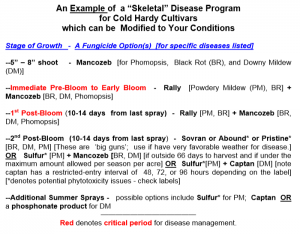Grape maturity
We have begun weekly preharvest sampling of the winegrapes at the UVM Horticulture Research and Education Center. Right now, grapes are about a week ahead of last year’s ripeness schedule, and with warm/hot, dry weather this week, ripening should advance quickly. I still don’t expect harvest to begin for another couple of weeks for most varieties.
Sampling results for 2015 can be found at: http://www.uvm.edu/~fruit/grapes/uvmvineyard/2015UVMfieldtesting.pdf
Past year’s sampling may be found at: http://www.uvm.edu/~fruit/?Page=grapes/uvmvineyard/uvmvineyardhorticulturearchives.html&SM=gr_submenu.html
Petiole sampling
Growers may ascertain overall nutritional status in their vineyards at two times through petiole analysis: bloom and 70-100 days post-bloom.Now is the time for late (post-veraison/pre harvest) petiole sampling for plant nutrient status. Dr. Joe Fiola form the University of Maryland has posted some good recommendations in his latest Timely Viticulture newsletter:
- Grape petiole analysis is recommended along with soil samples and visual observations as part of a complete nutrient management program.
- A three year cycle of sampling all of the varieties in a vineyard is typically recommended.
- Tissue/petiole analyses reveal the actual nutrients in the vines.
- Spring tissue sampling is a good time to sample, as you can make nutrient adjustments to the vineyard that will influence this year’s crop quality.
- Nitrogen status is best evaluated with tissue sampling not soil sampling.
Some specifics on sampling:
- Each sample should be less than 5 acres; less if there are major changes in soil or topography
- Sample different varieties separately. Samples should represent plants that are planted on the same soil type and are of the same age, variety and rootstock.
- Vines should represent that portion of a block that is maintained under the same cultural practices, i.e. fertilizer, irrigation and vigor control practices. For example, irrigation blocks are not to be combined with non-irrigated blocks even if they are on the same soil type.
- Do not sample vines on the border of the block or near dusty roads.
- For the late-season sampling period, sample the petiole of the most recent- FULLY EXPANDED leaf (NOT the one across from the first blossom cluster as during bloom).
- About 75-100 (depending on size) petioles are needed as they are typically smaller at the end of the shoot.
- Gently wash petioles with water and gentle detergent, pat dry and place in OPEN paper bag (lunch, #6 size) to dry for a few days.
- The closest analytical lab for grape petiole analysis is the Cornell Nutrient Analysis Laboratory . Please note that they now have partnered with Agro-One Services. It is recommended that you contact them before you send any samples to confirm that recommendations will be sent along with the analysis and to confirm costs.
Video about petiole sampling: https://www.youtube.com/watch?v=8EHbojLfXek







